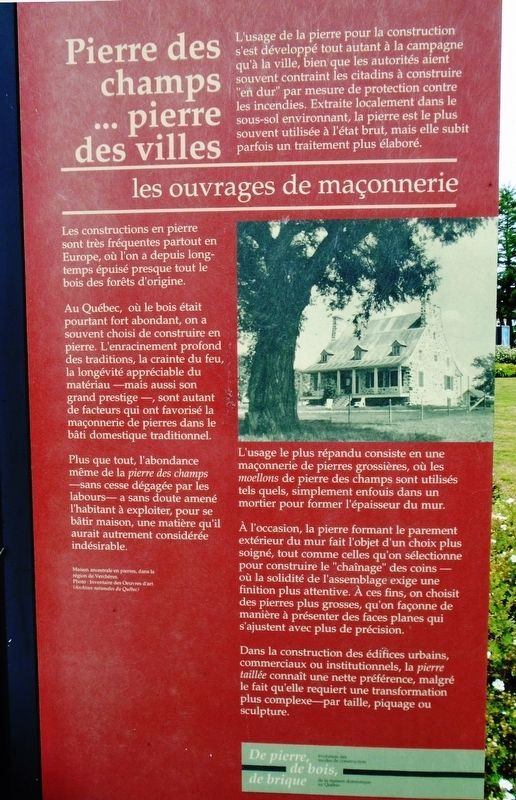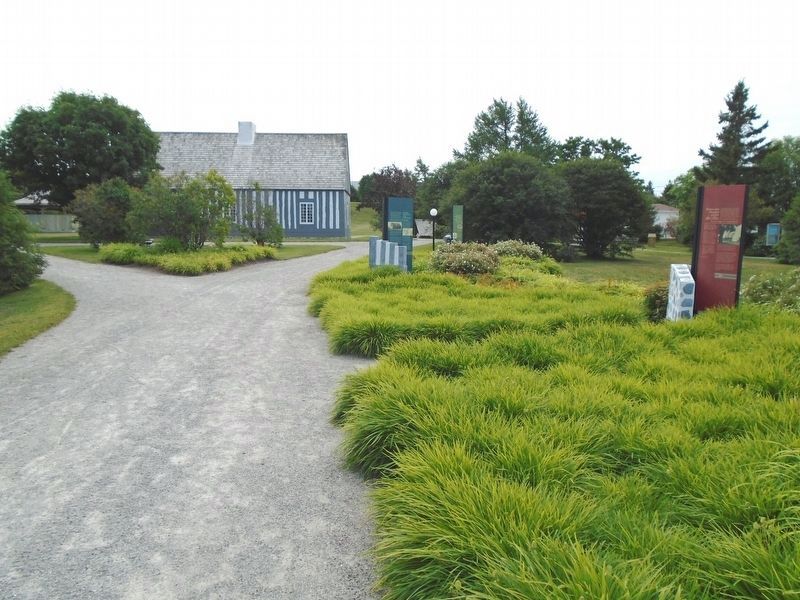Pierre des champs... pierre des villes / Stones of the fields... stones of the cities
les ouvrages de maçonnerie / the works of masonry
— De pierre, de bois, de brique / Stone, Wood, Brick —
L'usage de la pierre pour la construction s'est développé tout autant à la campagne qu'à la ville, bien que les autorités aient souvent contraint les citadins à construire "en dur" par mesure de protection contre les incendies. Extraite localement dans le sous-sol environnant, la pierre est le plus souvent utilisée à l'état brut, mais elle subit parfois un traitement plus élaboré.
Les constructions en pierre sont très fréquentes partout en Europe, où l'on a depuis longtemps épuisé presque tout le bois des forêts d'origine.
Au Québec, où le bois était pourtant fort abondant, on a souvent choisi de construire en pierre. L'enracinement profond des traditions, la crainte du feu, la longévité appréciable du matériau —mais aussi son grand prestige —, sont autant de facteurs qui ont favorisé la maçonnerie de pierres dans le bâti domestique traditionnel.
Plus que tout, l'abondance même de la pierre des champs —sans cesse dégagée par les labours— a sans doute amené l'habitant à exploiter, pour se bâtir maison, une matière qu'il aurait autrement considérée indésirable.
L'usage le plus répandu
consiste en une maçonnerie de pierres grossières, où les moellons de pierre des champs sont utilisés tels quels, simplement enfouis dans un mortier pour former l'épaisseur du mur.À l'occasion, la pierre formant le parement extérieur du mur fait l'objet d'un choix plus soigné, tout comme celles qu'on sélectionne pour construire le "chaînage" des coins —où la solidité de l'assemblage exige une finition plus attentive. À ces fins, on choisit des pierres plus grosses, qu'on façonne de manière à présenter des faces planes qui s'ajustent avec plus de précision.
Dans la construction des édifices urbains, commerciaux ou institutionnels, la pierre taillée connaît une nette préférence, malgré le fait qu'elle requiert une transformation plus complexe—par taille, piquage ou sculpture.
[La légende de la photo se lit]
Maison ancestrale en pierres, dans la région de Verchères.
The use of stone for construction developed just as much in the countryside as in the city, although authorities often forced city dwellers to build "hard" for fire protection. Extracted locally in the surrounding area, stone was most often used in its raw state, but sometimes underwent a more elaborate treatment.
Stone construction was very common throughout Europe, where almost all the wood of the original
In Quebec, where wood was abundant, we often chose to build with stone. The deep rooting of tradition, the fear of fire, the appreciable longevity of the material - but also its great prestige - were all factors that have favored stone masonry in traditional domestic building.
More than anything, the sheer abundance of fieldstone, disturbed by plowing, no doubt led the settler to exploit, to build himself a house, using a material that would otherwise have been considered undesirable.
The most common use was a coarse stone masonry, where the rubble stone was used as is, simply buried in a mortar to form the thickness of the wall.
Occasionally, the stone forming the exterior wall facing was more carefully selected, as were those selected for the "chaining" of the corners - where the solidity of the joint required a more attentive finish. For these purposes, larger stones were chosen, which were shaped so as to have plane faces that fit more precisely.
In the construction of urban, commercial or institutional buildings, cut stone is a clear preference, despite the fact that it requires a more complex transformation-by sizing, stitching, or sculpting.
[Photo caption reads]
Ancestral stone house in the Verchères region.
Topics. This historical marker is listed in these topic lists: Agriculture
Location. 48° 29.063′ N, 68° 29.726′ W. Marker is in Rimouski, Québec, in Rimouski-Neigette. Marker is on boulevard du Rivage (Québec Route 132), on the right when traveling north. Marker is on the grounds of Maison Lamontagne House Historic Site. Touch for map. Marker is at or near this postal address: 707 boulevard du Rivage, Rimouski QC G5L 7L3, Canada. Touch for directions.
Other nearby markers. At least 8 other markers are within walking distance of this marker. Façons de France ...en Amérique / French Ways ...in America (here, next to this marker); Le temps de s'établir / Time to Settle (a few steps from this marker); Une forêt pour sa maison / A forest for his house (a few steps from this marker); Un jeu de blocs... d'argile / A set of blocks ... of clay (a few steps from this marker); Maisons des faubourgs / Suburban Houses (within shouting distance of this marker); Du moulin à la maison / From the mill to the house (within shouting distance of this marker); La maison rurale du Bas-Canada / The Rural House of Lower Canada (within shouting distance of this marker); Villas et villégiature / Villas and Resorts (within shouting distance of this marker). Touch for a list and map of all markers in Rimouski.
Regarding Pierre des champs... pierre des villes / Stones of the fields... stones of the cities. Marker is one of a series highlighting the evolution of Quebec domestic architecture, titled, Stone, Wood, Brick.
Also see . . .
1. Maison Lamontagne House Historic Site. (Submitted on December 3, 2018, by William Fischer, Jr. of Scranton, Pennsylvania.)
2. The old architecture of Quebec (Traquair, 1947). (Submitted on December 3, 2018, by William Fischer, Jr. of Scranton, Pennsylvania.)
Credits. This page was last revised on January 20, 2020. It was originally submitted on December 3, 2018, by William Fischer, Jr. of Scranton, Pennsylvania. This page has been viewed 181 times since then and 23 times this year. Photos: 1, 2. submitted on December 3, 2018, by William Fischer, Jr. of Scranton, Pennsylvania.

